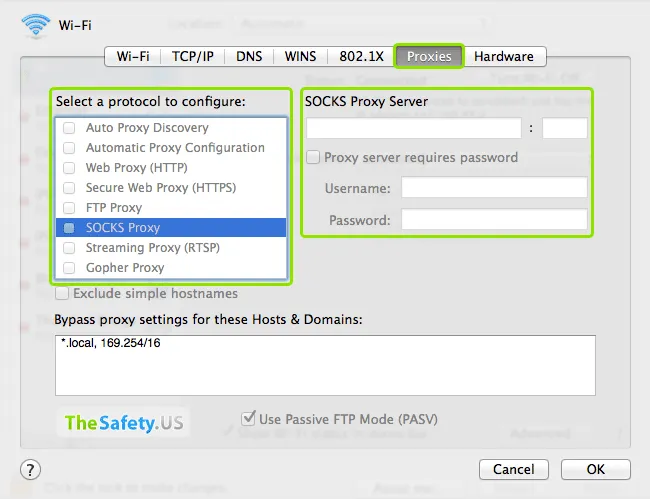You cannot set a proxy 'just for Skype'. The Skype developers have not programmed that option and therefore it does not exist. Mac OS X and for example Windows only allow you to set a system-wide proxy. Unless the developer of an application allows you to set an application-specific proxy, you cannot set a proxy without a third party application. You can set up a proxy server on a Mac. Introduction If you ever use your Mac on a large network such as at work, at a university or at a library, you will probably need to set up a proxy. Networks use proxies to control and limit access from unauthorized users to unauthorized content. In addition, proxies make network speeds faster because a.
After updating to Mojave, I started having connection issues (email mostly but also internet at times). It turns out, I had SOCKS Proxy selected in my Network Preferences. I deselected and applied my changes. But whenever I restart my computer, SOCKS Proxy autoselects. Is this Malware or a Virus? It's annoying but if benign, I can continue to deselect it. However, I know that botnets use SOCKS Proxy to control computers so I would prefer to disable it permanently. Any suggestions?
MacBook Pro (Retina, 13-inch, Mid 2014)
Posted on
In computer networks, a proxy server is a server (a computer system or an application) that acts as an intermediary for requests from clients seeking resources from other servers. A client connects to the proxy server, requesting some service, such as a file, connection, web page, or another resource available from a different server and the proxy server evaluates the request as a way to simplify and control its complexity.

If your computer is connected to a local network that’s protected from the Internet by a firewall, you may need to specify proxy servers or use the FTP passive mode (PASV) to access some Internet sites. When you configure a proxy server on your Mac, applications will send their network traffic through the proxy server before going to their destination.
The proxy server that you set below will be used by Apple Safari, Google Chrome, and other applications that respect your system proxy settings. Some applications like Mozilla Firefox, have their own custom proxy settings.
Setting Proxy For Mac Os
Steps To Manually Change Your Proxy Server Settings in Mac:
How To Restore Proxy Settings
1. Open the System Preferences application in your Dock, or else go to the Apple menu and click System Preferences. Now go to Network Panel icon.
2. The Internet panel shows all the available interfaces. Click the interface you want to configure (usually Ethernet or Wi-Fi).
3. Now Click the “Advanced” button at the bottom right corner of the Network window.
4. Select the “Proxies” tab. If you configure your proxy server settings automatically, select Auto Proxy Discovery to automatically discover proxy servers, or select Automatic Proxy Configuration. If you never want your Mac to use a proxy, even if one is detected with WPAD, leave this box unchecked.
5. If you’re using an automatic proxy configuration (PAC) file. If you select Automatic Proxy Configuration, enter the address of the PAC file in the URL field. Check with your network administrator if you need more information. For example, this setting may be used on business or school networks. If you don’t need to use an automatic proxy configuration script to configure your proxy settings, leave this box unchecked.
6. If you want to manually configure a proxy, you’ll need to enable one or more of the “Web Proxy (HTTP)”, “Secure Web Proxy (HTTPS)”, “FTP Proxy”, “SOCKS Proxy”, “Streaming Proxy (RTSP)”, and “Gopher Proxy” checkboxes.
7. Select a proxy server, such as FTP Proxy, then type its address and port number in the fields on the right. Select the “Proxy server requires password” checkbox if the proxy server is protected by a password. Enter your account name and password in the Username and Password fields. If you don’t want to manually configure a proxy, ensure all these boxes are unchecked.
8. The “Exclude simple hostnames” checkbox allows you to bypass the proxy for all “simple hostnames”. These are often used on local networks and intranets.
9. You can also choose to bypass proxy settings for specific computers on the Internet (hosts) and segments of the Internet (domains) by adding the address of the host or domain in the “Bypass proxy settings for these Hosts & Domains” field.
To add your own domain names and addresses, just separate each with a comma and space. For example, to tell your Mac to access alltop9.com without going through the proxy, you’d change the line to *.local, 192.254/16, alltop9.com
If you have issues connecting to FTP servers after configuring an FTP proxy, ensure the “Use Passive FTP Mode (PASV)” option is enabled at the bottom of the window here. It’s enabled by default. Click “OK” to save your settings and click “Apply” and your changes will take effect.
This is the step-by-step process to configure your proxy server settings in Mac. If you face any difficulties in the above process, let us know in the comments below. We are happy to help you with required solutions.
If you know any other methods to configure proxy server settings in Mac, do let us know in your comments. We will try it and update the article.

